Vertical Farming: growing up
By Frank Buhagiar on Wednesday 2 November 2022
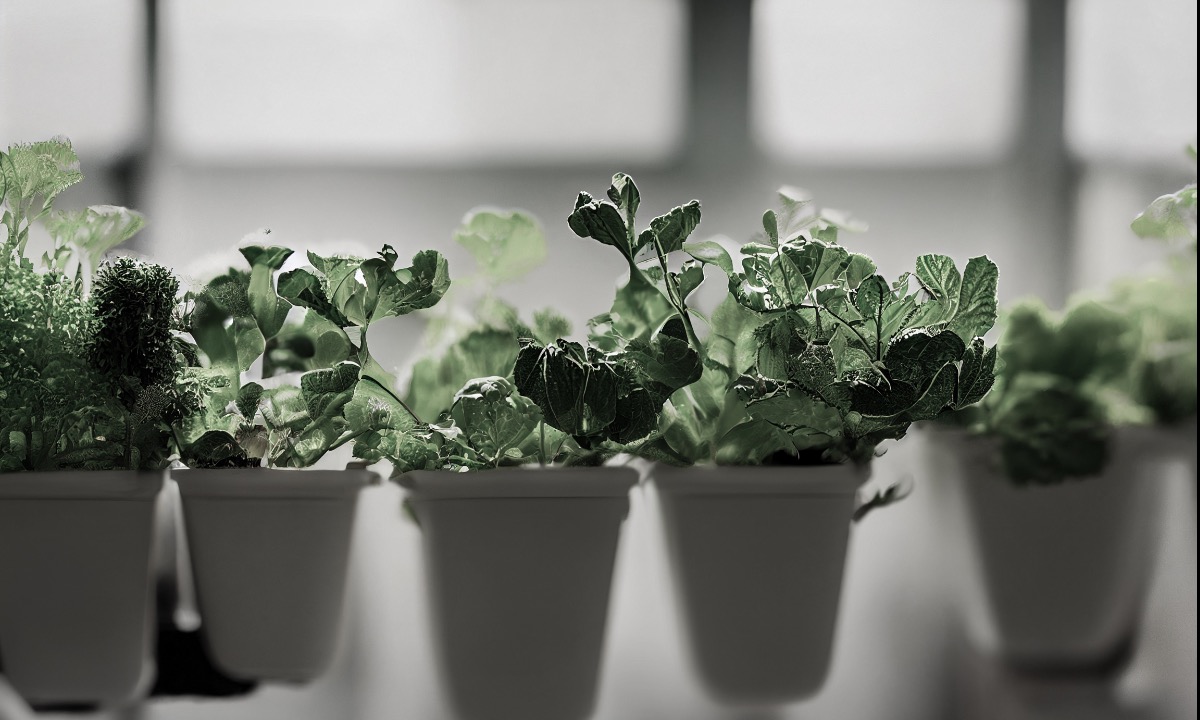
By Frank Buhagiar on Wednesday 2 November 2022

What is it?
It’s all in the name. Farming: specifically, growing produce. Vertical: specifically upwards. Put them together and you have a definition for vertical farming - producing food on vertically inclined/stacked surfaces as opposed to the traditional method of farming vegetables and food on a single, horizontal level, such as in a field or a greenhouse. Growing up rather than growing out.
But vertical farming is much more than growing food on multiple levels stacked one above each other. It involves growing food in controlled environments and deploying advanced technologies to control taste, texture and speed of production, all in the name of optimising output. These technologies range from controlled LED lighting to replicate the natural sunlight spectrum necessary for photosynthesis, drip irrigation to save water, all the way to the Internet of Things, Artificial Intelligence, Machine Learning and robotics to improve production, quality and productivity.
And because much lower quantities of fertilisers and zero-chemical pesticides are used, vertical farming produces pesticide-free, non-GMO and organic equivalent food, which can be as healthy, if not healthier, than organic food. By being in well-controlled environments, vertical farms can grow food anywhere in any climate and in any country with access to a power source and water. Just as well…
The Problem
…because the traditional agricultural system appears to be broken.
Five things that are wrong with traditional agriculture:
Easier said than done. In 2020, land equivalent to the size of South America was being used as arable land. If the projections prove to be correct, by 2050, feeding a population of 10 billion will require more land equivalent to the size of Brazil. That’s not all. Global supply of land is actually falling. It is estimated a third of all arable land has been lost to climate change and soil erosion over the past 40 years.
Traditional agriculture is plagued with concerns over the freshness, health and nutrition of food as well as the consumer’s health and ecological sustainability. Solutions are required.
The Solution
Vertically-farmed healthy, fresh, nutrient-rich and non-GMO food solves many of the issues related to traditional farming. By operating in a controlled environment and in an ecologically efficient manner, it opens an array of opportunities for sustainable food sourcing, and at the same time has the potential to produce over 350x more food per square yard than a traditional farm, thanks to faster growth cycles and quicker harvests.
Key benefits of vertical farming:
How does it work?
Hydroponics, aeroponics and aquaponics – the three methods used in vertical farming. All are ecologically efficient, reduce pollutants released into the environment and produce healthier and more nutritious food:
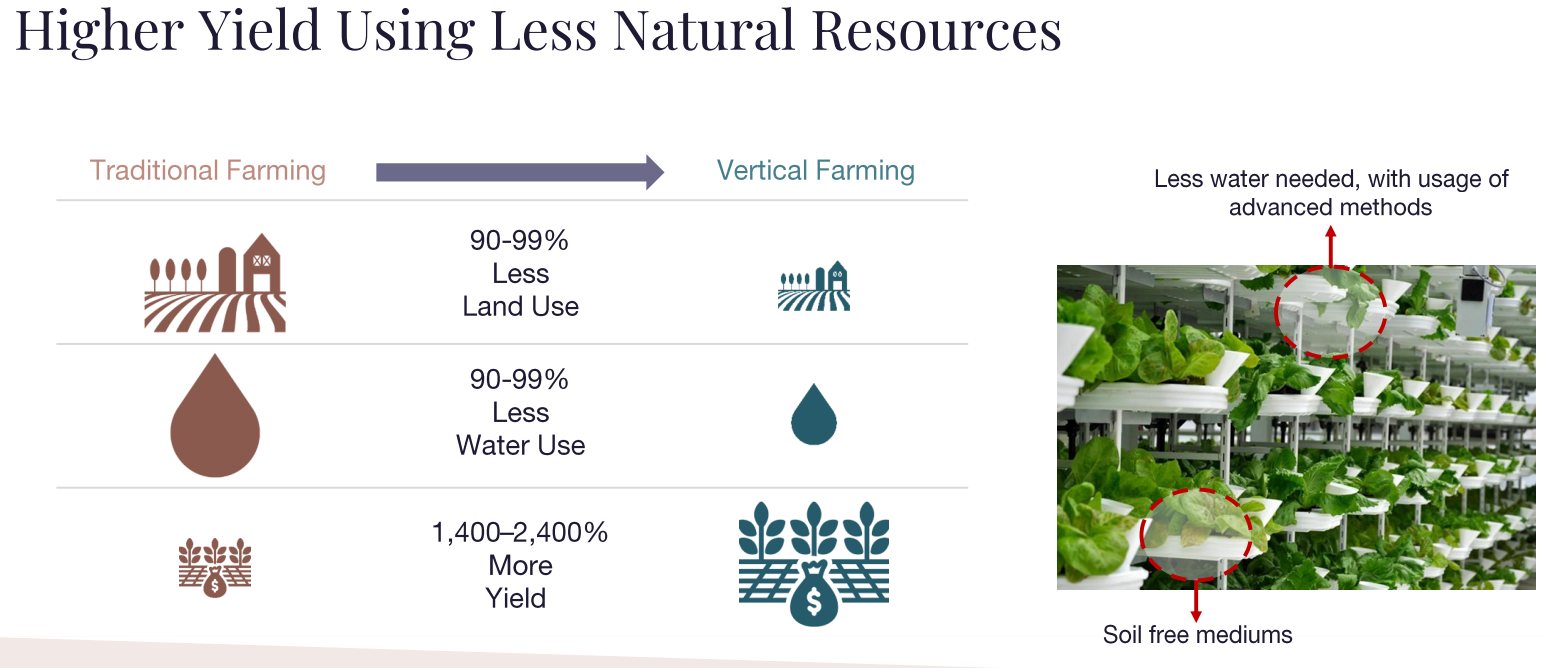
Timeline
Vertical farming has come a long way in a short space of time. But there is still a way to go. Below is a timeline of vertical farming covering both the past and a possible future:
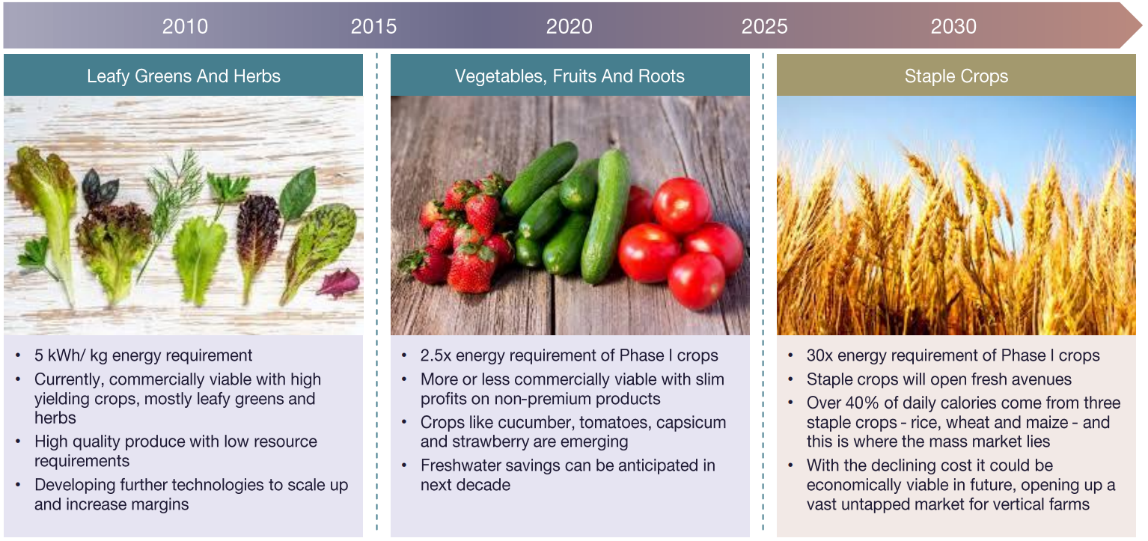
The future
Staple crops are a big prize. Using a crop simulation tool, researchers found that a 10-floor vertical farm, covering one hectare of ground space and operating under optimal conditions was able to generate about 600x greater yield than the average amount produced on one hectare of ‘horizontal’ farmland. This has major implications as the benefits of indoor vertical wheat facilities could be particularly valuable in buffering the effects of climate-related events, health concerns and other anomalies in food production globally.
Why now?
By exposing the unstable nature of the conventional food ecosystem and by causing mounting global food shortages, the pandemic laid bare the faults of the traditional agricultural system, thereby accelerating the need for innovation:
The exposed fault lines include:
The National Sustainable Agriculture Coalition estimates US$1.32 billion farm losses in the US between March to May 2020 due to Covid-19. Furthermore, the pandemic provided a major push towards locally sourced food. Thanks to year-round availability, the healthy food produced and the food security provided, the value of vertical farming came to the fore.
An obstacle
Vertical farming requires energy. Energy costs money. It therefore follows that high energy costs act as a growth inhibitor. But there is a solution, one that is in keeping with vertical farming’s high sustainability credentials – the use of sustainable energy sources such as solar power, wind turbines and other clean energy alternatives. These sources are increasingly providing a cheaper source of electricity in many parts of the world, and as they do vertical farms are harnessing renewables for their energy needs. For example, in Germany, Farmers Cut has deployed a combination of solar plants and batteries to reduce power costs.
The graphics below highlight how energy costs are on a downward trajectory, one that is expected to continue in the years ahead:
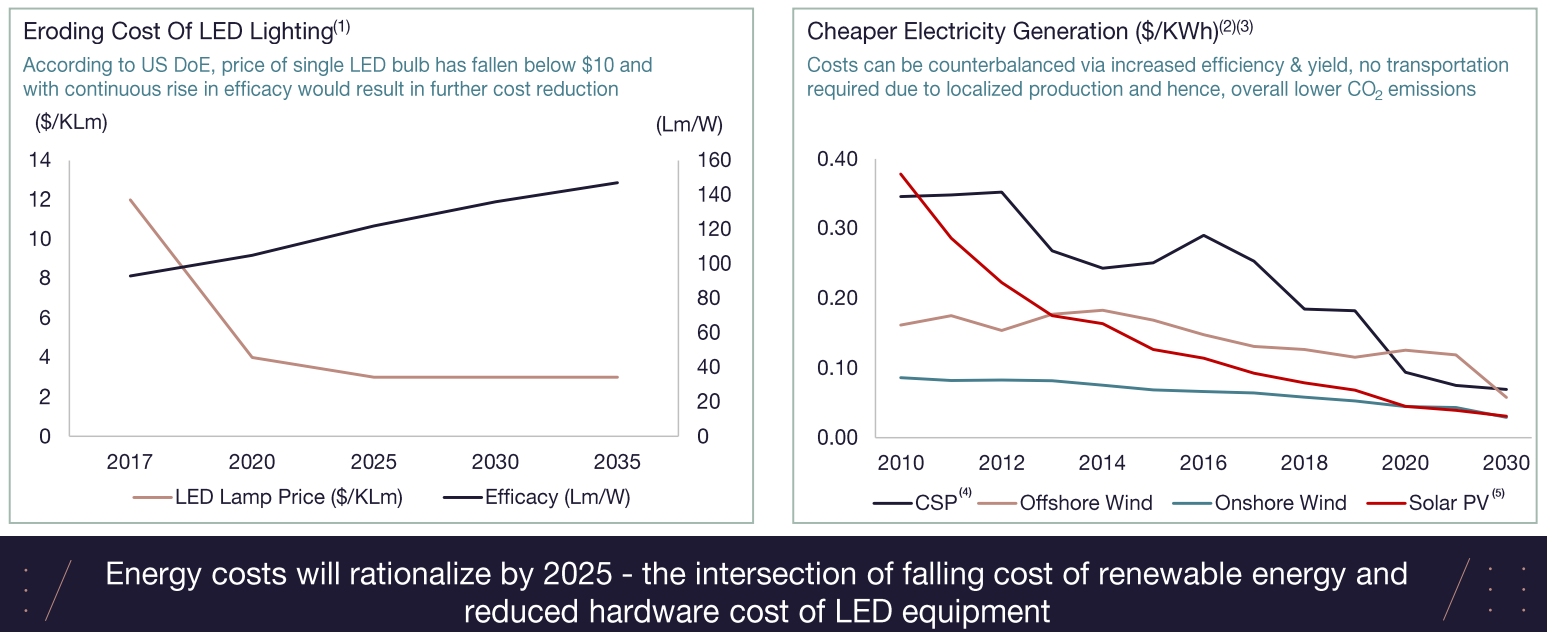
As costs tumble, the energy cost problem associated with vertical farms should tumble too.
Size of market
Key benefits such as proximity to urban cities and pesticide-free, year-round consistent, nutritious and healthy produce have helped vertical farms make strong inroads in the food production market:
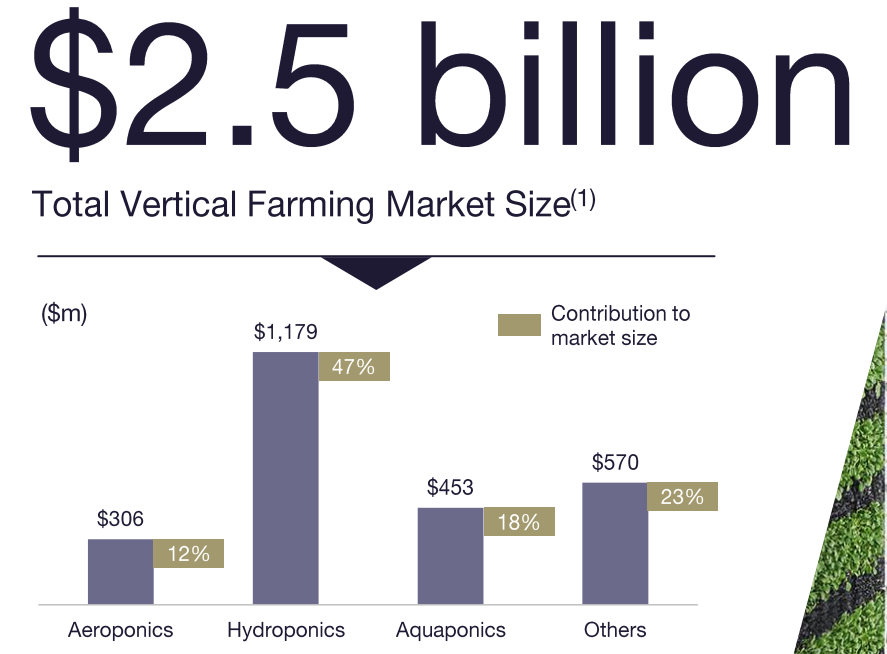
If the forecasts are correct, there is more to come. Between 2020-2030, the global vertical farming market is expected to grow at a CAGR of c. 60%.
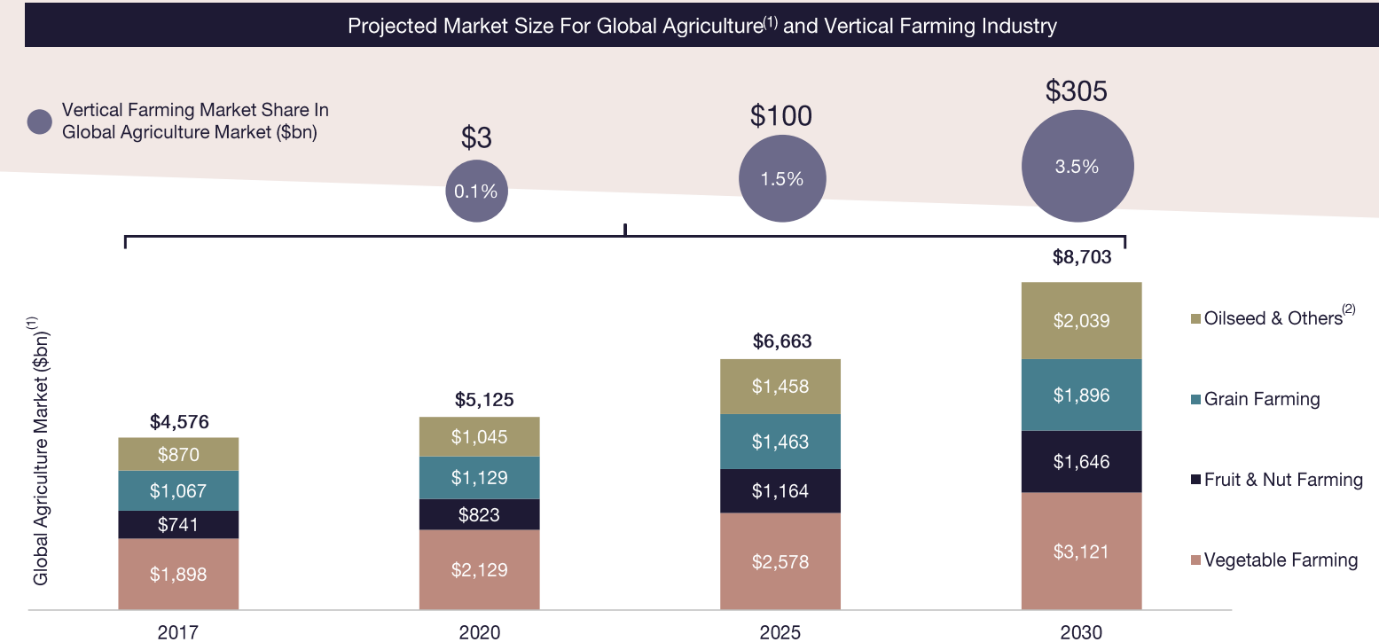
Who are the leading players?
North America with c. 26.9% CAGR over the 2018-24 period and Europe with a CAGR of c. 26% over the 2019-2026 period lead global demand for vertically-farmed food. Together, these two regions account for around two thirds of global demand. In August 2022, The Guardian wrote: “It’s estimated there are more than 2,000 vertical farms in the US growing produce such as lettuce, herbs and berries. Market leaders such as Plenty, Bowery, Kalera and AeroFarms – which can operate 365 days a year regardless of weather conditions – and sprawling greenhouses from companies like AppHarvest and Gotham Greens, see themselves as part of the solution.”
Other regions are getting in on the act too. AeroFarms, for example, is constructing a 90,000 sq.ft. vertical farm in Abu Dhabi on the back of an undisclosed amount of investment by Abu Dhabi Investment Office (ADIO). As for China, Fox News recently reported: “Over the past decade, China has spent trillions of dollars for agriculture technology. It's also invested in some of the most high tech agriculture equipment. Drones used to spray pesticides, A.I. technology and genetic research to increase its pig population and pork production and greenhouses and indoor farming to grow crops year round… Vertical farming has also grown in popularity in China. With the world's largest population, space can be limited in urban areas. Farmers have resorted to growing up rather than out.”
At the company-level, the below graphic compares three of the major vertical farm players:
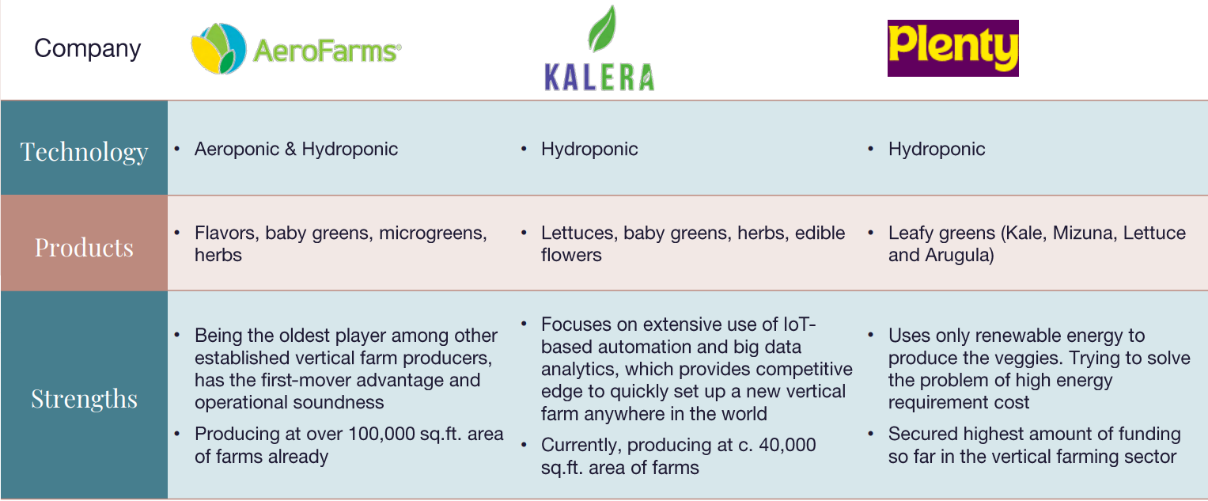
Growing up
Reaching for the stars is associated with setting lofty goals and by growing upwards, vertical farming is doing just that. By tackling some of the major issues of the day – food security and traceability, excessive use of harmful pesticides and GMOs, reduction in food wastage, sustainability, feeding a growing global population, protecting the environment – vertical farming offers investors not just exposure to a growing industry that is already up and running, but also the opportunity to help bring about positive change.
2 August 2021
Paul Cuatrecasas
30 June 2021
Paul Cuatrecasas
13 September 2021
Paul Cuatrecasas
9 September 2021
David Stevenson